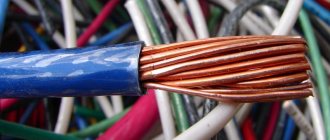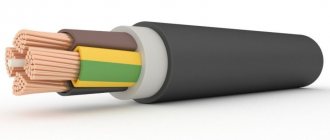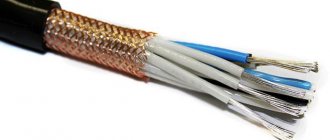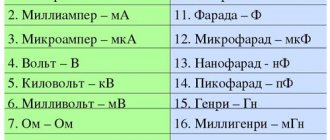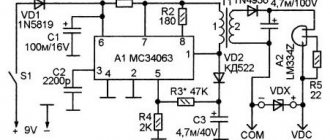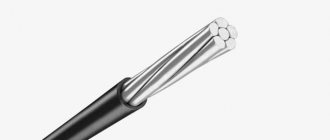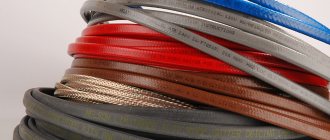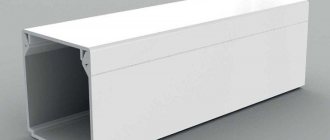Converting wire cross-section from AWG to mm2
Americans not only think completely differently, they also use a completely different measurement system. In particular, they use a system for classifying the cross-sectional area of a wire not in square millimeters, but in AWG units.
AWG translates to American Wire Gauge - American wire thickness, literally. The AWG system is based on inches, like other linear measurements in America.
In Europe, including Russia and Germany, a system for designating wire cross-section based on square millimeters is used. For more details on what this means, see the article Table for selecting wire cross-sectional area on SamElectric.ru.
By the way, if you are at all interested in what I write about, subscribe to receive new articles and join the group on VK!
The higher the wire number in the AWG system, the smaller the wire diameter it indicates - the opposite is true.
AWG - American wire gauge
The abbreviation AWG (American Wire Gauge) literally stands for “American wire gauge”. The word caliber is used here for a reason. Overseas electricians mark wiring in a slightly different way than Russian ones. The calculation does not take into account the cross-section of the current-carrying core in square millimeters, but the number of cycles of drawing and thinning the wire.
For example, an AWG 0 wire with a diameter of 8 mm and a cross-section of 50.24 sq. mm passed through the rollers of the rolling machine 0 times. Essentially, this is a blank for making thinner cores. Conductor AWG 24 with a diameter of 0.51 mm and a cross-section of 0.204 sq. mm was rolled 24 times, so it is 100 times thinner.
Cable gauge AWG
This approach to designating a section creates difficulties for domestic specialists. Indeed, according to this standard, AWG 0 has a larger cross-section than 24.
PoE
One of the most popular questions about 28 AWG cables is whether this cable supports PoE (Power over Ethernet)? Now we can definitely answer - yes! Cables from well-known brands support all modern PoE standards: IEEE 802.3 af PoE, 802.3 at PoE+ and 802.3 bt (PoE++). This makes it economical to use thin cables to connect power to CCTV cameras, remote sensors, access points, etc. You just need to remember one nuance: a thin cable assembled into bundles will generate more heat than standard cables. Temperatures may rise up to 15°C higher than specified in TSB 184.
Origin of the marking
Previously, in the USA, wiring was made using the drawing method. A solid copper rod corresponding to AWG 0 caliber was taken. Then it was threaded into special rolling machines. The wire passed through a series of rollers and decreasing holes. As a result, its diameter was reduced to the required value.
If the workpiece went through 1 thinning cycle, then the output was AWG 1 wire. If 2, then AWG 2. The number of cycles reached several tens. With each passage through the machine, the conductor became thinner in cross-section, but 1 unit larger in caliber.
It is worth noting that AWG 0 is not the thickest wire. In addition to it, there are calibers 00, 000 and 0000. But they are used much less frequently. In this case, the more zeros in the decoding, the thicker the wire.
Important! It is necessary to distinguish between AVVG and AWG cables. These are completely different types of conductor products that have similar designations.
Cable assignment
AWG conductors are used in the same industries as any other similar in structure. Most often these are the following areas of application:
- Construction of communication lines. If there is a screen, the cables can be used to lay the Internet or telephone network.
- Use in audio technology. AWG 22 and 24 transmit sound in some headphone models. This speaker wire is suitable for such purposes due to its high flexibility.
- Most wiring in cars is done using AWG wire. Typically 23 gauge twisted pair is used.
- Connecting LED strips and other low-voltage diode lighting sources. Due to its small thickness and flexibility, it fits conveniently into the grooves for wiring. This property allows you to create a hidden power line.
- Thin wires with a gauge of less than 24 are used in alarm and automation systems. From them lines are drawn for temperature, pressure and humidity sensors of industrial equipment.
Speaker Wire AWG
Air flow optimization
Cooling is one of the main problems of modern data centers, especially in racks and cabinets with a lot of cable. The use of thin cables really helps to optimize the cooling process, because their diameter is smaller, as a result of which they take up less space in front of the patch panels and in the switching areas with active equipment - the main source of hot air. The additional free space allows for optimized air circulation within the rack or cabinet for better cooling of equipment.
Cable structure
AWG cables have the same structure as the wires used in Russia. It is based on 2 elements:
- current-carrying conductor;
- layer of protective insulation.
The current conductor is made of electrical copper. Due to its chemical purity, it is possible to achieve a minimum specific resistance of the finished product. The cores can be single-wire (monolithic) or multi-wire (flexible). What to choose depends on the situation. If the installation is complex and there are a lot of wire bends to be made, then flexible cables must be used. If the wiring must remember its shape, then it is monolithic.
Additionally, current-carrying conductors can be tinned with a layer of tin. This increases their anti-corrosion properties and facilitates future soldering.
The insulation is made of foamed polyethylene. In some modifications, additives are added to the composition to increase elasticity or frost resistance. A shielding layer may be located under the insulation. In this case, the conductor becomes resistant to external interference.
terms of Use
Tension Cable
AWG cables have the same insulation layer and outer sheath as traditional metric wire. When installing products and their operation, you must follow the basic rules:
- When laying a line in the ground, it is impossible to install conductors without a protective corrugation or asbestos sleeve.
- When tensioning wires between supports, it is necessary to use guide cables that relieve tension from the conductors.
- If the cable is laid on the bottom of a reservoir, its connections must be carefully insulated with polyethylene foam.
Do not apply more voltage to the conductors than its specific rating - this can lead to overheating and short circuits.
Multi-wire cables
Stranded AWG wires are woven from many solid wires. Each individual current conductor has individual polypropylene insulation. A separate protective layer is applied on top of it. Sometimes it is supplemented with armor.
A common example of multi-core cables is twisted pair. Due to the twisting of the wires, the wire has increased elasticity, which makes its installation more convenient. And a large number of color combinations of individual conductors is beneficial from a marking point of view. Such a cable is often supplemented with a thin but strong thread. It is necessary to increase tensile strength. Also used for quick and convenient cable cutting.
Twisted pair AWG
Additional Information. There are flexible stranded AWG cables with silicone insulation. This material can withstand temperatures of hundreds of degrees without melting. Therefore, such wiring is used in devices with increased heat generation or where large currents flow through the conductor for a short time.
Cable design and composition
Since products corresponding to American caliber are produced in different formats, tailored for certain purposes, they also differ in internal structure. Cables can be single-core or multi-core, equipped with a foil screen. Insulating shells can also be made from different materials, for example, polypropylene foam is very popular. The veins themselves can be made of aluminum or copper. In some cases, the strands are twisted into a spiral.
The number of core elements and their cross-section significantly affect the characteristics of conductors. For example, thick elements are more resistant to heat under high loads, so for the corresponding networks you need to choose products of greater thickness - in these conditions they are more reliable and durable than thin ones. Thick and multi-core cables have a lower resistance value than thin and single-core cables.
Conversion table for AWG wires to mm2
There are difficulties in understanding AWG wire gauges. The larger the caliber, the thinner the core thickness. This discrepancy creates problems during repair and wiring design.
In order not to have to calculate the cable cross-section every time or not to use calculators, experts have created a special table of wires. It shows the relationship between AWG gauge, its cross-section and the maximum permissible current.
| Wire gauge | Section, sq. mm | Continuous permissible current, A (with insulation, at 60°C) |
| 0000 | 107 | 195 |
| 000 | 85 | 165 |
| 00 | 67,4 | 145 |
| 0 | 53,5 | 125 |
| 1 | 42,4 | 110 |
| 2 | 33,6 | 95 |
| 3 | 26,7 | 85 |
| 4 | 21,2 | 70 |
| 5 | 16,8 | – |
| 6 | 13,3 | 55 |
| 7 | 10,5 | – |
| 8 | 8,37 | 40 |
| 9 | 6,63 | – |
| 10 | 5,26 | 30 |
| 11 | 4,17 | – |
| 12 | 3,31 | 25 |
| 13 | 2,62 | – |
| 14 | 2,08 | 20 |
| 15 | 1,65 | – |
| 16 | 1,31 | 15 |
| 17 | 1,04 | – |
| 18 | 0,823 | 10 |
| 19 | 0,653 | – |
| 20 | 0,518 | 5 |
| 21 | 0,41 | – |
| 22 | 0,326 | 4,5 |
| 23 | 0,258 | – |
| 24 | 0,205 | 2,1 |
| 25 | 0,162 | – |
| 26 | 0,129 | 1,3 |
| 27 | 0,102 | – |
| 28 | 0,081 | 0,83 |
| 29 | 0,064 | – |
| 30 | 0,051 | 0,52 |
| 31 | 0,04 | – |
| 32 | 0,032 | 0,32 |
| 33 | 0,025 | – |
| 34 | 0,02 | 0,18 |
| 35 | 0,016 | – |
| 36 | 0,013 | – |
| 37 | 0,01 | – |
| 38 | 0,0079 | – |
| 39 | 0,0063 | – |
| 40 | 0,005 | – |
AWG Standard Information
| Solid wire | ||||
| AWG | Diameter, mm | Section area, mm² | Linear resistance, Ohm/km | Linear weight, kg/km |
| 4 | 5,189 | 21,15 | 0,815 | 188,0 |
| 6 | 4,115 | 13,30 | 1,297 | 118,2 |
| 8 | 3,264 | 8,37 | 2,061 | 74,38 |
| 10 | 2,588 | 5,26 | 3,277 | 46,77 |
| 11 | 2,304 | 4,17 | 4,134 | 35,05 |
| 12 | 2,052 | 3,31 | 5,217 | 29,46 |
| 13 | 1,829 | 2,626 | 5,562 | 23,36 |
| 14 | 1,628 | 2,084 | 8,268 | 18,45 |
| 15 | 1,450 | 1,652 | 10,43 | 14,69 |
| 16 | 1,290 | 1,309 | 13,19 | 11,62 |
| 17 | 1,151 | 1,039 | 16,57 | 9,24 |
| 18 | 1,024 | 0,826 | 20,96 | 7,32 |
| 19 | 0,912 | 0,652 | 26,41 | 5,80 |
| 20 | 0,813 | 0,519 | 33,14 | 4,61 |
| 21 | 0,724 | 0,412 | 41,99 | 3,66 |
| 22 | 0,643 | 0,325 | 53,15 | 2,89 |
| 23 | 0,574 | 0,259 | 66,60 | 2,31 |
| 24 | 0,511 | 0,205 | 84,32 | 1,82 |
| 25 | 0,455 | 0,163 | 106,3 | 1,44 |
| 26 | 0,404 | 0,128 | 134,5 | 1,14 |
| 27 | 0,361 | 0,102 | 168,8 | 0,91 |
| 28 | 0,320 | 0,081 | 214,2 | 0,72 |
| 29 | 0,287 | 0,065 | 266,4 | 0,58 |
| 30 | 0,254 | 0,051 | 341,2 | 0,45 |
| 31 | 0,226 | 0,040 | 427,0 | 0,359 |
| 32 | 0,203 | 0,032 | 538,0 | 0,238 |
| 33 | 0,180 | 0,025 | 679,0 | 0,226 |
| 34 | 0,160 | 0,020 | 856,0 | 0,179 |
| 35 | 0,142 | 0,016 | 1086,0 | 0,142 |
| 36 | 0,127 | 0,013 | 1361,0 | 0,113 |
| AWG | Number and diameter of cores, AWG (mm) | Conductor diameter, mm (nom.) | Section area, mm² | Linear weight, kg/km | Linear resistance, Ohm/km |
| 4 | 7×12 (2,052) | 6,16 | 23,2 | 212,0 | 0,78 |
| 4 | 19×17 (1,151) | 5,75 | 19,8 | 181,0 | 0,92 |
| 6 | 7×14 (1,628) | 4,88 | 14,6 | 131,0 | 1,24 |
| 6 | 19×19 (0,912) | 4,56 | 12,4 | 114,0 | 1,46 |
| 8 | 7×16 (1,290) | 3,87 | 9,15 | 83,8 | 1,98 |
| 8 | 19×21 (0,724) | 3,62 | 7,82 | 71,6 | 2,32 |
| 8 | 49/25 (0,455) | 3,734 | 8,00 | 70,7 | 2,20 |
| 10 | 37×26 (0,404) | 2,921 | 4,77 | 42,1 | 3,64 |
| 10 | 49×27 (0,361) | 2,946 | 5,04 | 44,5 | 3,58 |
| 10 | 105×30 (0,254) | 2,946 | 5,37 | 47,3 | 3,22 |
| 12 | 7×20 (0,813) | 2,438 | 3,66 | 32,3 | 4,76 |
| 12 | 19×25 (0,455) | 2,370 | 3,10 | 24,43 | 5,58 |
| 12 | 65×30 (0,254) | 2,413 | 3,32 | 29,26 | 2,74 |
| 14 | 7×22 (0,643) | 1,854 | 2,28 | 20,2 | 7,58 |
| 14 | 19×27 (0,361) | 1,854 | 1,95 | 17,2 | 8,86 |
| 14 | 41×30 (0,254) | 1,854 | 2,09 | 18,5 | 8,30 |
| 16 | 7×24 (0,511) | 1,524 | 1,44 | 12,7 | 12,0 |
| 16 | 19×29 (0,287) | 1,473 | 1,24 | 10,9 | 14,0 |
| 16 | 26×30 (0,254) | 1,499 | 1,33 | 11,7 | 13,1 |
| 18 | 7×26 (0,404) | 1,219 | 0,90 | 8,0 | 19,2 |
| 18 | 16×30 (0,254) | 1,194 | 0,82 | 7,2 | 21,3 |
| 18 | 19×30 (0,254) | 1,245 | 0,97 | 8,6 | 17,9 |
| 20 | 7×28 (0,320) | 0,960 | 0,56 | 5,2 | 32,0 |
| 20 | 10×30 (0,254) | 0,889 | 0,51 | 4,5 | 33,9 |
| 20 | 19×32 (0,203) | 0,940 | 0,62 | 5,5 | 28,3 |
| 22 | 7×30 (0,254) | 0,762 | 0,36 | 3,2 | 48,4 |
| 22 | 19×34 (0,160) | 0,787 | 0,38 | 3,4 | 45,1 |
| 22 | 26×36 (0,127) | 0,762 | 0,33 | 2,9 | 52,3 |
| 24 | 7×32 (0,203) | 0,610 | 0,23 | 2,2 | 76,4 |
| 24 | 10×34 (0,160) | 0,582 | 0,20 | 1,8 | 85,6 |
| 24 | 19×36 (0,127) | 0,610 | 0,24 | 2,1 | 69,2 |
| 26 | 7×34 (0,160) | 0,483 | 0,142 | 1,25 | 122,4 |
| 26 | 10×36 (0,127) | 0,533 | 0,128 | 1,13 | 136,1 |
| 26 | 19×38 (0,102) | 0,508 | 0,156 | 1,37 | 113,0 |
| 27 | 7×35 (0,143) | 0,457 | 0,112 | 0,99 | 178,7 |
| 28 | 7×36 (0,127) | 0,381 | 0,072 | 0,79 | 212,9 |
| 28 | 19×40 (0,079) | 0,406 | 0,093 | 0,82 | 186,0 |
| 30 | 7×38 (0,102) | 0,305 | 0,057 | 0,50 | 338,6 |
| 30 | 19×42 (0,064) | 0,305 | 0,061 | 0,53 | 286,4 |
| 32 | 7×40 (0,079) | 0,203 | 0,034 | 0,30 | 538,1 |
| 32 | 19×44 (0,051) | 0,229 | 0,039 | 0,34 | 447,5 |
| 34 | 7×42 (0,064) | 0,191 | 0,022 | 0,20 | 777,6 |
| 36 | 7×44 (0,051) | 1,152 | 0,014 | 0,13 | 1217,2 |
Tags: machine, ampere, beat, sconce, view, choice, house, , protective, sign, insulation, cable, how, , installation, load, voltage, num, rule, wire, project, start, , size, calculation, reves, repair, row, garden, light, LED, system, resistance, ten, type, current, , shield
Formulas for calculation
When dealing with AWG wires and calculating their cross-section, you can use the formulas below.
Convert caliber to diameter (inches inch)
Where,
- n - wire gauge;
- dinch - diameter in inches.
Convert caliber to diameter (in mm)
Where,
- n - caliber;
- dmm — wire diameter, mm.
In some situations it is necessary to calculate the wire cross-section by gauge. For a similar case, a formula (simplified) is also derived:
Here,
- An - wire cross-section, sq. mm;
- n - caliber (note the “-” sign);
And finally, a few general formulas that will be useful in calculations. Wire cross-section through diameter:
Where,
- A - wire cross-section, sq. mm (inches);
- d—diameter, mm (inches).
Convert diameter in inches to millimeters:
Here,
- dmm - wire diameter in mm;
- dinch - diameter in inches.
Electricians' Observations
Over the years, practicing electricians have noticed a number of empirical facts that relate to the diameter and cross-section of AWG wiring. The main ones are:
- If you increase the wire gauge by 4 points, it will be able to withstand 2 times the melting current. This approach allows you to select the cross-section of cores without calculators and formulas.
- If you increase the cross-sectional area of the cable core by 2 times, then its caliber will decrease by 3 points. This value is approximate, but in some cases this accuracy is sufficient.
- Increasing the diameter of the wire by 2 times leads to a decrease in its caliber by 6 positions. This pattern was also discovered experimentally.
Important! If you are repairing an electrical appliance with a heating element, then it will most likely have a wire in heat-resistant silicone insulation. It cannot be replaced with a conductor with a regular, easily melting protective layer.
More information about AWG
- To describe stranded wires according to the AWG standard, the sum of the parameters of all cores is calculated without taking into account the space between the cores, which can be up to 10% of the total value. The designation of stranded conductors consists of three parameters: the gauge of the entire wire, the number of conductors and the gauge of the conductor; the number of conductors and their gauge are separated by a slash. For example, “22 AWG 7/30” is 22 AWG stranded wire assembled from seven 30 AWG conductors;
- Doubling the wire diameter reduces the gauge by 6 (for example, AWG 10 wire is about half as thin as AWG 4 wire);
- Doubling the cross-sectional area of a wire results in a reduction in gauge by 3 (for example, two AWG 10 wires roughly correspond to one AWG 7 wire in cross-sectional area);
- Reducing the gauge by 4 doubles the wire's melting current (for example, AWG 14 copper wire melts at 166A, and AWG 10 copper wire melts at 333A);
- Reducing the gauge by 10 increases the area and weight by about 10 times and reduces the drag by about 10 times.
Performance characteristics
AWG standard wiring has the same technical characteristics and operating conditions as cables familiar to Russian electricians. Therefore, these types of conductor products have common features:
- The cable insulation must not be damaged. This point should be checked when laying or installing wiring. Cracks and holes in the protective insulating layer will lead to moisture entering the cable cavities and the risk of it burning out.
- AWG wire is selected according to the permissible current and operating voltage. If the current value is exceeded, the cable insulation will melt. And if you overdo the voltage, an insulation breakdown will occur.
- Along the walls, cables are laid in separate fire protection. For example, in an installation channel or corrugation. This rule is especially relevant for wooden buildings.
- There should be no open sections of current-carrying conductors. Regardless of voltage. All connections are sealed with insulating tape or heat-shrinkable tubing.
Heat Shrink Waterproof Splice for AWG
From a design perspective, AWG is no different from other types of installation wire. The only difference is in the markings. The higher the gauge of the wire, the thinner it is. Such a system is the opposite of that adopted in the countries of the post-Soviet space.
AWG wire is universal. It is suitable for installation of lighting systems, auto electrics, sound and signal networks. When using it, the main thing is not to get confused about the diameter of the current-carrying wires. There are special formulas for calculating the required wiring cross-section and converting it into the usual square meters. mm.

